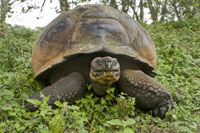Chelonoidis elephantopus, extinct on its home island has been breeding with Chelonoidis becki on Isabela Island
Click image to enlarge Chelonoidis becki, above has been breeding with the once thought extinct Chelonoidis elephantopus. Photo credit: Thinkstock |
Scientists studying the Galapagos tortoise have determined that the once thought extinct Chelonoidis elephantopus species that lived on Floreana Island is living on Isabela Island based on a 2011 DNA analysis of more than 1600 tortoises living on Isabela, according to a paper published this week.
In their paper, "Genetic rediscovery of an extinct Galápagos giant tortoise species," and published in the January 10 issue of Current Biology, the scientists detail a discovery of genes from a species of Galapagos tortoise thought to have been extinct since the 1800s in another species of Galapagos tortoise from a different island. The "extinct" species, Chelonoidis elephantopus lived on Floreana Island but were thought to have all been killed by whalers for food in the 1800s. Researchers have now found DNA evidence showing that the extinct species is in fact not extinct and must be living on nearby Isabela Island along with native populations of Chelonoidis becki, which is native to Isabela Island.
The scientists conducted blood samples of 60 tortoises living on Isabela Island in 1994, and determined that a distinct group of tortoises had genetically divergent DNA than that of the other tortoises on the island. As DNA analysis technology improved over the years, the scientists then analyzed museum bone and shells of Chelonoidis elephantopus and determined that the genetically divergent species had come from Floreana Island. The scientists speculate that the tortoises were brought to Isabela Island by whalers in the late 1880s and were either dropped or escaped captivity, enabling them to interbreed with the native tortoises. Of the more than 1600 tortoises recently analyzed in 2011, 84 were determined to be hybrids, carrying genes from both the Isabela and the Floreana tortoises. Thirty of the hybrid tortoises were younger than 15 years, indicating a recent breeding between the two species.
While a purebred Chelonoidis elephantopus has not yet been found, the scientists feel fortunate that the tortoises are reproducing. A workshop has been planned to determine what can be done now, and to plan a trip back to the Galapagos this year to locate a purebred Floreana Galapagos tortoise.
The complete paper can be found at Current Biology.



